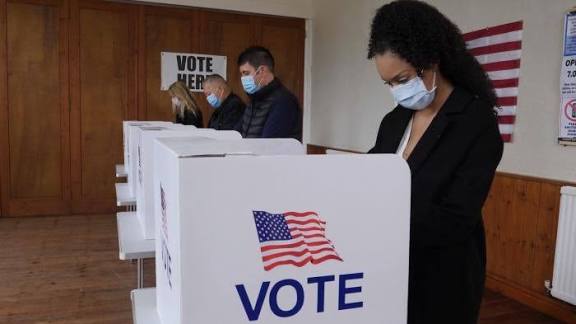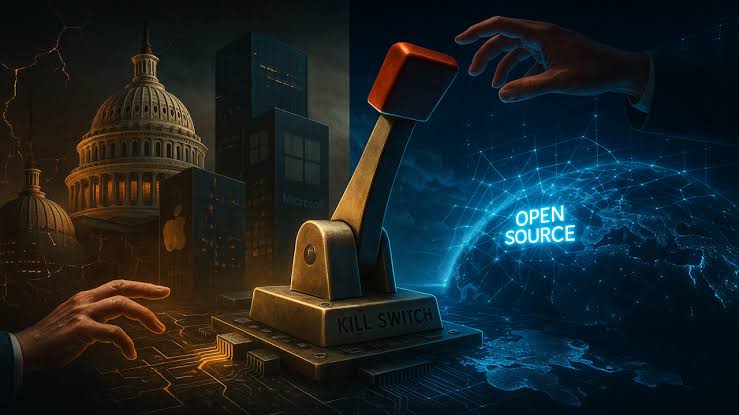BREAKING: US Voters Losing Trust in Both Parties

Although there is not a single “breaking news” report with that exact headline, various recent analyzes and surveys confirm ongoing events. Today we will discuss about BREAKING: US Voters Losing Trust in Both Parties
BREAKING: US Voters Losing Trust in Both Parties
For decades, American politics has been defined by a binary choice: Democrats or Republicans. But a striking development is unfolding across the nation — trust in both major parties is collapsing. New national polling reveals that Americans are growing dissatisfied with the political establishment as a whole, not just one side of the aisle. This growing frustration is shaping voter behavior, reshaping political expectations, and raising urgent questions about the future of American democracy.
From perceptions of corruption to feelings of ideological extremism, Americans are sending a clear message: the traditional two-party system no longer reflects their needs, values, or priorities. This article explores what is driving this collapse in trust, what it means for the future, and how both parties are struggling to adapt.
The Erosion of Trust: What Recent Polls Show

A wave of polling over the past year paints a stark picture. Americans are not simply unhappy with one particular party — they are unhappy with both.
Falling Favorability for Both Parties
Recent nationwide surveys show that:
Favorability ratings for Republicans have fallen into the low 40s.
Favorability ratings for Democrats have dropped even further, into the high 30s.
A majority of Americans now view both parties unfavorably, a trend that has persisted for years.
This means the problem is not a momentary spike in frustration. It is a long-term pattern of disillusionment.
Low Confidence in Party Ethics
One of the most alarming findings is the low percentage of Americans who believe either party is ethical or honest. Barely four in ten voters say they consider either political party trustworthy.
This is not a partisan issue. Voters across the political spectrum — Republicans, Democrats, and independents — overwhelmingly say they doubt the honesty of both parties’ leaders, candidates, and institutions.
Widespread Perception of Extremism
A majority of Americans believe both parties have become too extreme, though slight differences exist in how each is viewed. The overarching sentiment is clear: voters feel alienated by what they see as increasingly polarized, uncompromising positions.
Negative Emotional Reactions Are Rising
Most strikingly, voters now describe their emotional response to both parties using words like:
Anger
Frustration
Disappointment
Disgust
Fewer than one in three Americans say either party makes them feel hopeful. Pride is at historic lows. This emotional decline reflects a deeper collapse of trust that goes beyond policy disagreements.
Why Americans Are Losing Trust
The erosion of trust in both major parties stems from a combination of political, economic, institutional, and cultural factors. Below are the most significant drivers.
1. Ethical Concerns and Perceived Corruption
Trust is closely tied to the belief that elected officials act in the public’s interest. But many Americans now believe both parties are compromised by:
Lobbyists
Wealthy donors
Corporate interests
Internal scandals
Political favoritism
Growing concerns about ethics, transparency, and honesty have fueled a belief that the political system is rigged or unresponsive.
Both parties struggle with the perception that they prioritize power and partisanship over governing.
2. Ideological Extremism and Polarization
Americans increasingly believe their political leaders have moved away from the center and become more extreme. This perception applies to both parties, although one may be viewed as more extreme than the other depending on the issue.
This sense of extremism stems from:
Partisan media
Culture war narratives
Outspoken ideological factions
Social media echo chambers
Polarizing national leaders
As parties shift toward their ideological bases, many voters — especially moderates and independents — feel left behind.
3. Frustration Among Each Party’s Own Base
The disillusionment is not limited to independents.
A significant portion of Democratic voters say they feel frustrated with their own party’s direction. Many cite internal division, lack of strong messaging, and failure to address economic needs.
Republicans also express dissatisfaction with their leadership, though traditionally Republican voters show slightly more internal loyalty. However, internal divisions still exist over issues like foreign policy, spending, and the role of social conservatism.
The fact that both parties face internal frustration indicates a deeper identity crisis within the U.S. political system.
4. Misalignment on Key Issues
Polls show large numbers of Americans believe neither party represents their views on major issues like:
Immigration
Economy and jobs
Crime and policing
Climate change
Healthcare
Reproductive rights
In many policy areas, over a quarter of the population says neither party aligns with their beliefs.
This suggests that voters want more nuanced approaches rather than rigid ideological frameworks.
5. Failure of Institutions and Processes
Americans are also losing trust in the broader political system that the parties operate within.
Many voters feel:
Primaries are unrepresentative
Party elites control candidate selection
Money dominates politics
Elections lack transparency
Internal party rules are unfair
A significant number of voters say the nomination process used by both parties is outdated and undemocratic. This weakens trust even before the general election campaign begins.
6. Cynicism, Fatigue, and Political Burnout
After years of hyper-partisanship, investigations, culture wars, and media conflicts, many Americans are simply exhausted. Political fatigue contributes to:
Declining civic engagement
Low turnout in primaries
Growing number of independent voters
Distrust of government generally
This exhaustion fuels cynicism, reinforcing the belief that neither party is capable of meaningful change.
Consequences for American Politics
The collapse of trust in both major parties has significant — possibly historic — consequences.
A. The Rise of Third Parties and Independents
With dissatisfaction growing, more Americans say they want options beyond Democrats and Republicans. Support for a viable third party has climbed sharply.
This does not guarantee the rise of a major new party, but it does signal an environment ripe for:
Independent candidates
Issue-based movements
State-level third-party successes
Reform-oriented political groups
Whether these alternatives can break through remains to be seen, but voter appetite is clearly growing.
B. Increasing Electoral Volatility
Voters who feel unrepresented are unpredictable. This could lead to:
More swing elections
Unusual combinations of voter coalitions
Unexpected upsets
Declining voter loyalty
Higher rates of protest voting
Traditional models of political behavior may become less reliable as party loyalty weakens.
C. Intensified Gridlock and Institutional Paralysis
When both parties lose credibility, governing becomes harder.
Low trust can lead to:
Weak mandates
Legislative dysfunction
Difficulty negotiating bipartisan agreements
Reduced faith in major institutions
A government that lacks public confidence struggles to implement policy, even when its leaders agree on solutions.
D. Pressure for Systemic Reform
As distrust grows, public pressure increases for major reforms, including:
Ranked-choice voting
Open primaries
Campaign finance reform
Term limits
Ballot access reform
Anti-gerrymandering laws
Such reforms could reshape American politics, but they will require broad coalitions and public demand.
Challenges Facing Both Parties
If Democrats and Republicans hope to regain trust, they must address several major challenges:
1. Deepening Internal Divisions
Each party must confront growing ideological rifts within its base. Without unity, rebuilding trust becomes nearly impossible.
2. Balancing Moderates and Activists
Parties struggle to satisfy both centrist voters and more fervent ideological wings. This tension often leads to mixed messaging and voter frustration.
3. Addressing Economic Anxiety
Economic insecurity remains a top concern for Americans. Many feel neither party is offering realistic, comprehensive solutions.
4. Reversing Decades of Polarization
Bridging the divide between parties — and within them — requires major shifts in political culture, leadership, and communication.
5. Countering Disinformation and Distrust
Misinformation and political cynicism create an environment where any attempt to rebuild trust faces immediate skepticism.
How Parties Could Earn Back Trust
While the task is difficult, there are concrete steps both parties could take:
Increase transparency in funding and internal processes
Address internal ethics scandals quickly and publicly
Champion bipartisan legislation that benefits broad groups
Engage more deeply with independent and moderate voters
Modernize party structures and nomination systems
Focus on practical solutions rather than ideological battles
Small, consistent steps toward accountability and representation could begin to rebuild confidence.
The Role of Voters in Shaping the Future
Voters, too, have a role in reshaping the political landscape:
Supporting reforms
Holding leaders accountable
Staying informed
Engaging in local politics
Running for office
Supporting alternative candidates where appropriate
Collective voter behavior influences whether change happens gradually or dramatically.
Conclusion
The breaking news is unmistakable: Americans are losing trust in both major political parties at historic levels. This trend is deep, long-lasting, and driven by a mix of ethical concerns, ideological extremism, institutional failures, and widespread dissatisfaction.
What comes next could reshape American politics. Whether it leads to reforms, new political movements, unstable elections, or further polarization depends on how parties — and voters — respond.
The two-party system is under unprecedented strain. The coming years will determine whether it adapts, fractures, or evolves into something new.
How useful was this post?
Click on a star to rate it!
Average rating 0 / 5. Vote count: 0
No votes so far! Be the first to rate this post.
About the Author
usa5911.com
Administrator
Hi, I’m Gurdeep Singh, a professional content writer from India with over 3 years of experience in the field. I specialize in covering U.S. politics, delivering timely and engaging content tailored specifically for an American audience. Along with my dedicated team, we track and report on all the latest political trends, news, and in-depth analysis shaping the United States today. Our goal is to provide clear, factual, and compelling content that keeps readers informed and engaged with the ever-changing political landscape.



